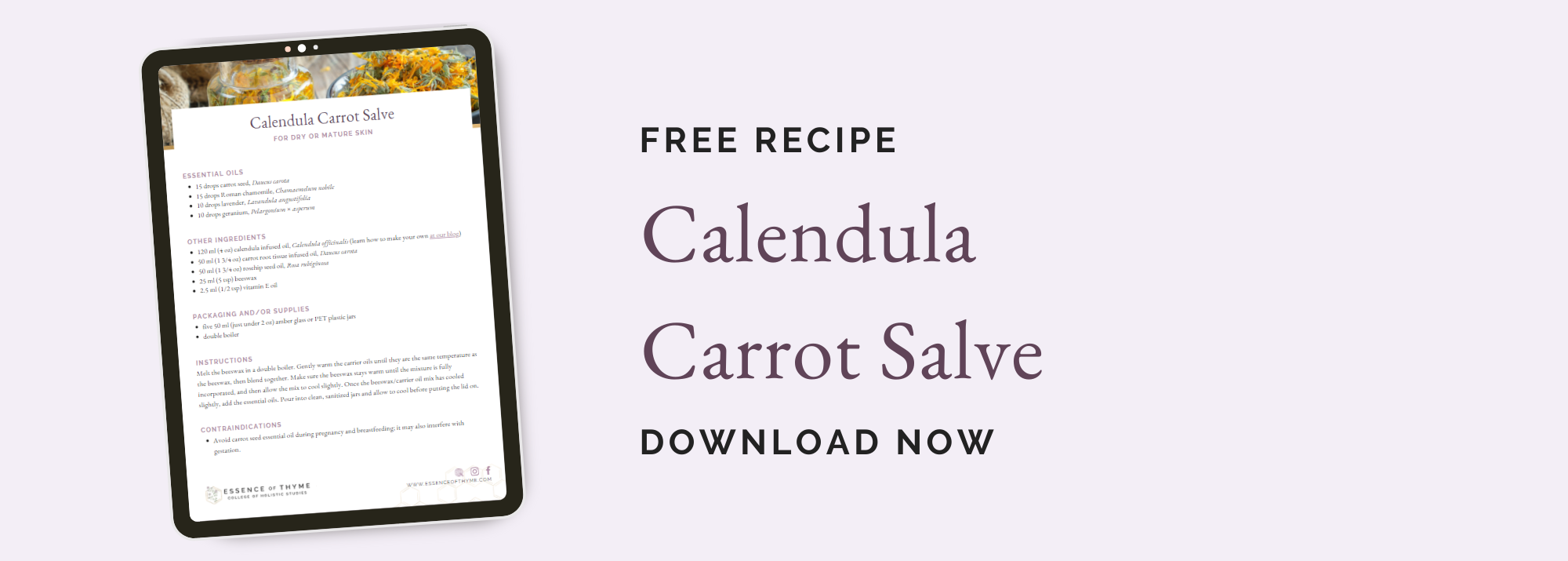Recipe: How to Make Calendula Infused Oil

Infused carrier oils are an asset to any aromatherapist: they’re gentle and versatile, and they lend their own beneficial properties to a product. Making your own infused carrier oils is easy, can be done at home, and gives you an opportunity to connect more fully with each plant and understand it holistically.
Because they are created with their end use in mind, it’s easy to end up with a large collection of infusions such as rose or lavender for a relaxing bath or St. John’s wort for muscle pain. Calendula, however, is among my favourites because it is useful in so many applications.
Here are some of the many concerns that infused calendula oil can support:
- acne
- bed sores
- broken capillaries
- bruising
- chapped lips
- cradle cap
- diaper rash
- eczema
- inflammation or muscle pain
- itchy skin
- psoriasis
- skin irritation
- sore, cracked nipples
- varicose veins
- ulcerated skin
- wounds
How to Choose the Right Carrier Oil for Your Infusion
The unique properties of each carrier oil should be a consideration, as they lend additional therapeutic benefit and determine how the infusion will feel on your skin. Carrier oils that I have used include virgin organic grapeseed oil (Vitis vinifera) and certified organic almond oil (Prunus amygdalus var. dulcis), but my favourite carrier oil for a calendula infusion is organic extra virgin olive oil (Olea europaea): it is a very stable carrier with a good shelf life, it absorbs well, and its deep green colour creates a beautiful infusion. I like to support local businesses, so I purchase mine from Basil Olive Oil Products Ltd. in British Columbia, Canada.
Using Fresh or Dried Flowers in an Infusion
I prefer organic dried calendula flowers for my infusions. You can use either the whole dried flower, as it is easier to strain, or just the dried petals. While you can use fresh flowers, their water content makes them prone to mould. Let fresh flowers wilt for at least 6–8 hours before infusing them, and make sure they are fully covered by the oil at all times to prevent contamination from contact with the air inside the jar.
Common Herbal Oil Infusion Methods
Solar Infusion
Solar infusion is a 2–week process, and is ideal for warmer weather. Add the calendula flowers to a large sanitized clear glass jar with a tight-fitting lid. Pour your carrier oil of choice over the flowers, making sure they are completely submersed. Leave the jar to rest in the sun all day, or about 12 hours. Place in a warm, dark cupboard at night for another 12 hours. Alternate between sun and dark for about 2 weeks, making sure that the oil is covering the flowers at all times. After 2 weeks, strain the mixture through several layers of unbleached cheesecloth or muslin to separate the spent flowers from the oil. You may need to strain several times until no residue remains in the oil.
Crockpot (Slow Cooker) Infusion
Dried calendula flowers allow you to make your infusion anytime during the year, not just when fresh flowers are available. Although I prefer the solar method, I have created excellent calendula infusions in a crockpot during the winter. Place the calendula flowers in a crockpot and cover completely with the carrier oil of your choice. Set your crockpot to its lowest heat setting and infuse for 8–10 hours, stirring every hour or so. Allow the infusion to cool slightly before straining in the same manner as for solar infusion.
How to Store Your Infused Oil
For both infusion methods, pour your infused and fully strained oil into sanitized dark-coloured glass bottles. Label your bottle, including the name and date, and store in a cool, dark place. If you would like to use an antioxidant to extend shelf life, you can add 500 IU (international units) of vitamin E for every cup of infused oil.
How to Use Infused Calendula Oil
Infused carrier oils are incredibly versatile, lending their benefits to many types of aromatherapy preparations. You can use them on their own, add essential oils to them, or add them to salves or balms. I use calendula infused oil as a base for many of my aromatherapy preparations. Below is one of my favourites, perfect for dry or mature skin.
While infused oils are less concentrated than essential oils, be sure to research any potential contraindications before using.
Calendula Carrot Salve
makes approximately 250 ml (8.5 ounces)
Salve ingredients:
- 120 ml calendula infused oil, Calendula officinalis
- 50 ml carrot root tissue infused oil, Daucus carota
- 50 ml rosehip seed oil, Rosa rubiginosa
- 25 ml beeswax
- 2.5 ml vitamin E oil
Essential oil blend:
- 15 drops carrot seed, Daucus carota
- 15 drops Roman chamomile, Chamaemelum nobile
- 10 drops lavender, Lavandula angustifolia
- 10 drops geranium, Pelargonium × asperum
Instructions:
Melt the beeswax in a double boiler. Gently warm the carrier oils until they are the same temperature as the beeswax, then blend together. Make sure the beeswax stays warm until the mixture is fully incorporated, and then allow the mix to cool slightly. Once the beeswax/carrier oil mix has cooled slightly, add the essential oils. Pour into clean, sanitized jars and allow to cool before putting the lid on. I like to put it into five 50 ml amber glass jars.
Safety note: avoid carrot seed essential oil during pregnancy and breastfeeding; it may also interfere with gestation.
Have you infused your own carrier oils before? How do you like to use them?


Article by: Colleen Thompson, RA, MIFPA
For over 25 years, Colleen Thompson has been a passionate and highly respected aromatherapy educator. She has owned 3 aromatherapy stores and a holistic spa, and she founded Essence of Thyme in 1995, where she mentors budding aromatherapists from all over the world, helping them create their own thriving aromatherapy businesses.
About Essence of Thyme College of Holistic Studies
Essence of Thyme College of Holistic Studies offers 300- and 630-hour professional aromatherapy certification programs that help you grow a successful, fulfilling career by specializing and creating your market niche. Professional Level Certification prepares graduates to become aromatherapy consultants, launch product lines or retail businesses, or provide services as an adjunct to existing holistic health specializations. Master Level Certification and electives are ideal for certified aromatherapists seeking higher education or a path to clinical aromatherapy practice.
All Essence of Thyme programs focus on aromatherapy product development and advanced formulation, evidence-based research, spa and business management, international industry regulatory guidelines, and sustainability and conservation of essential oil and carrier oil-bearing plants.
Our comprehensive, evidence-based programs meet or exceed the criteria set forth by 5 international professional aromatherapy associations. Learn more about our aromatherapy certification programs.


